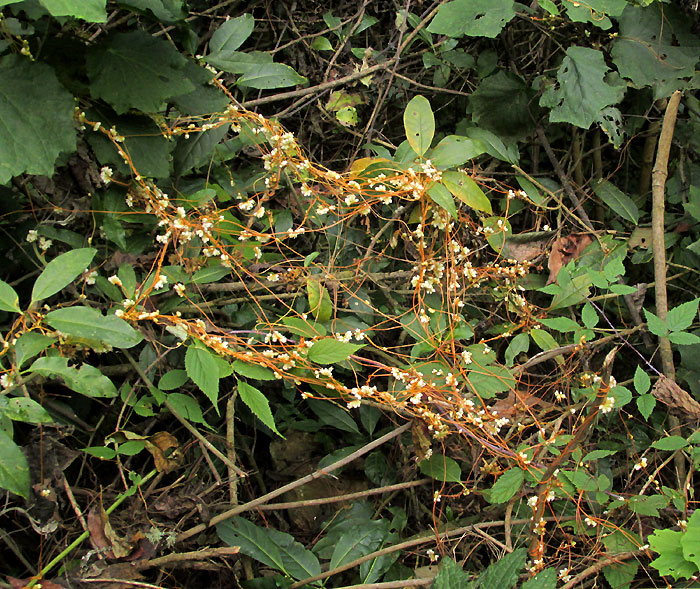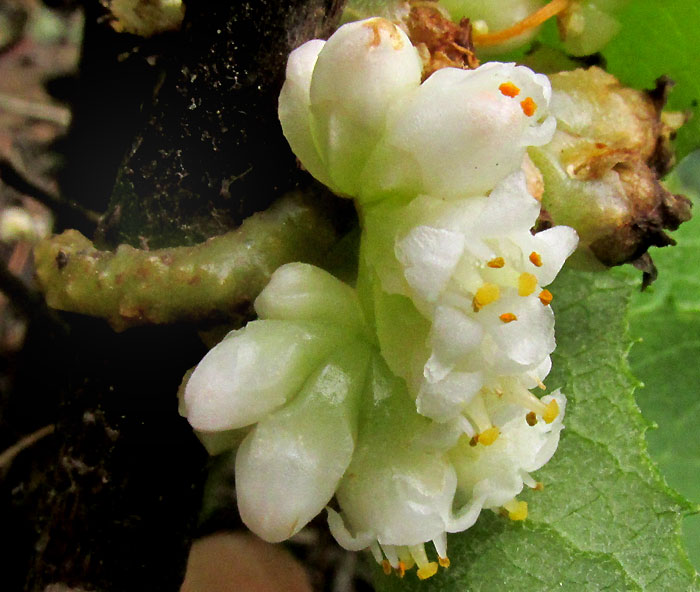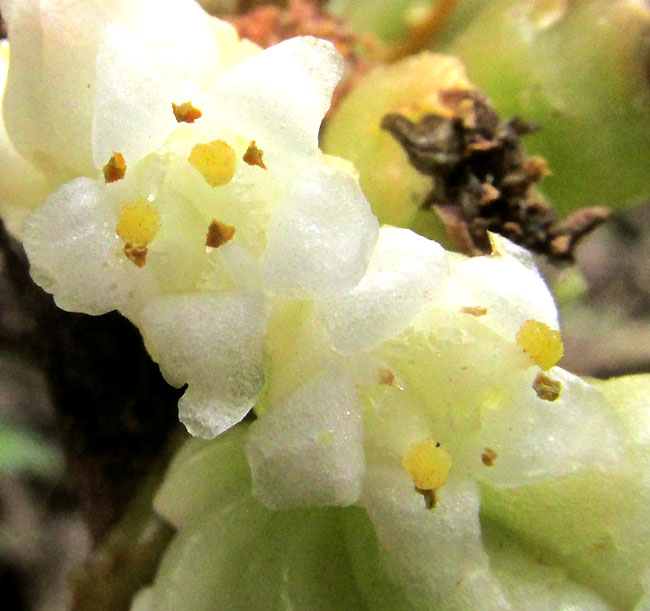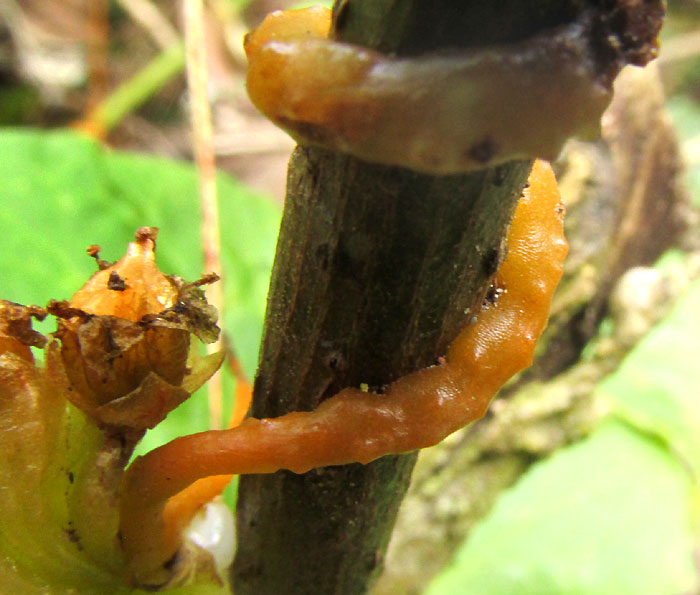Excerpts from Jim Conrad's
Naturalist Newsletter
entry from field notes dated January 19, 2023, taken along steep, one-lane gravel road ascending forested, northeast-facing mountain slope, elevation ±2,380m (7600 ft); bedrock of Cretaceous limestone; on the south side of Pinal de Amoles, Querétaro state, MÉXICO, (N21.134°, W99.629°)
CUSCUTA RUGOSICEPS

In a bushy, chopped-over place beside the rough gravel road up the hill, the above tangle of orange strands with white flowers spread atop weeds and bushes. Those passably familiar with their American weeds and wildflowers will recognize this as the parasitic vine known as dodder, genus Cuscuta. The plant isn't green because as a parasite it doesn't need chlorophyll for photosynthesis. It belongs to the Morning Glory Family, the Convolvulaceae. For some time it was considered such an oddball kind of plant that a family was erected just for the genus Cuscuta, the Cuscutaceae, but now gene-studying people say it really does belong among the morning glories.

The flowers, shown above, except for being all white and so small, in general are structured like regular morning glory blossoms: somewhat bell-shaped corollas; 5-5-5 in terms of number of sepals, corolla lobes and stamens, and; two-chambered, superior ovaries each with two styles.

On such white-on-white flowers it can be hard to see the parts. The picture above provides orientation, for in each blossom there are five dark yellow, pollen-producing anthers atop their stamens, and atop each white style -- one style topping each ovary chamber -- there's a pale yellow stigma. Also, in the lower blossom, possibly you can just make out a kind of five-lobed, crown-like structure surrounding the base of the ovary, and having five lobes fringed at their tops with white, hairlike projections. The crown-like structures' five lobes are known as "infrastaminal scales," and the structure is an obscure peculiarity of dodder flowers.

Above, an orange dodder stem twines around a host stem. At each bulge in the dodder stem an unseen, rootlike haustorium enters the parasitized plant's stem, where the haustorium taps into the victim's sap-conducting plumbing system, its xylem and phloem. An amazing feature of this process is that the cells at the tip of the dodder's probing haustoria alter their cell identity so that it conforms to whether the haustorium tip has found xylem or phloem cells. This is outlined in the 2022 study by Min-Yao Jhu and Neelima R. Sinha entitled "Cuscuta species: Model organisms for haustorium development in stem holoparasitic plants."
Also in the above picture, to the left of the spiraling dodder stem, there's a mature ovary enveloped below with a brown, drying-up corolla and stamens. In determining this dodder's ID to species level, it's necessary to notice that the two stiles atop the orange, two-chambered ovary are thick at their bases, but taper to a narrow point before the brown, dried stigmas appear. Many Cuscuta species produce flowers with style bases which don't thicken like that.
Over 200 dodder species occur worldwide, mainly with the greatest diversity in tropical and subtropical regions. Mexico is home to more than 60 species, and just in the semiarid upland part of central Mexico known as the Bajío region, about 15 species are recognized. In this area, if you have a Cuscuta with calyx lobes wider than they are long, broad, broadly rounded corolla lobes, the styles are as thick-based as the above photo shows, and the styles don't much bend away from one another, you have CUSCUTA RUGOSICEPS.
Cuscuta rugosiceps occurs from north-central Mexico south into Guatemala, mainly appearing in disturbed spots of various forest types, mostly oak and pine, at elevations of 1200-2900m (3900-9500ft).
At this time probably the most detailed investigation of Cuscuta rugosiceps is found in the 2013 work by Ignacio García Ruiz and Kristy Dockstader entitled "More Problems Despite Bigger Flowers: Systematics of Cuscuta tinctoria Clade (subgenus Grammica, Convolvulaceae) with Description of Six New Species." They wrote of Cuscuta rugosiceps that "The species is little known from biological and ecological points of view." Similarly little appears to be known about any aspect of the species, other than features of its anatomy, and that it's found in certain places represented by dots on maps.